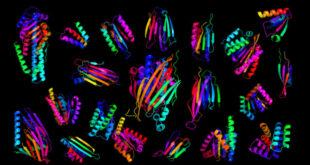A new study, published in the June 11 issue of the journal Cell Reports, found that poly(ADP ribose), or PAR, a molecule once thought only to exist inside cells for the purpose of repairing DNA, is responsible for hardening (biomineralization) of the arteries. Additionally, using rats with chronic kidney disease, the study found that minocycline — a widely-prescribed antibiotic often used to treat acne — could treat hardening of the arteries by preventing the build-up of calcium in the circulatory system.
Müller et al investigated the physicochemical process of extracellular matrix calcification in both physiological (bone) and pathological (vascular calcification) contexts; they found that oxidative stress-induced poly(ADP-ribose) nucleates calcium phosphatemineral crystals on extracellular matrix substrates and that calcification is inhibited by poly(ADP-ribose) polymerase (PARP) enzyme inhibitors. Image credit: Müller et al, doi: 10.1016/j.celrep.2019.05.038.
“Artery hardening happens to everyone as they age, and is accelerated in patients on dialysis, where even children develop calcified arteries. But up until now we haven’t known what controls this process and therefore how to treat it,” said University of Cambridge’s Professor Melinda Duer, senior author of the study.
“This hardening is essential for the production of bone, but in arteries it underlies a lot of cardiovascular disease and other diseases associated with aging like dementia.”
“We wanted to find out what triggers the formation of calcium phosphate crystals, and why it seems to be concentrated around the collagen and elastin which makes up much of the artery wall.”
Using NMR spectroscopy, Professor Duer and her colleagues found that when the cells become stressed and die, they release PAR, which binds very strongly to calcium ions.
Once released, PAR starts mopping up calcium into larger droplets which stick onto the components in artery walls that give the artery its elasticity, where they form ordered crystals and solidify, hardening the arteries.
“We never would have predicted that it was caused by PAR. It was initially an accidental discovery, but we followed it up — and it’s led to a potential therapy,” Professor Duer said.
Having discovered the links between DNA damage, PAR, bone and artery calcification, the researchers then looked into a way of blocking this pathway through the use of a PARP inhibitor.
“We had to find an existing molecule that is cheap and safe, otherwise, it would be decades before we would get a treatment,” said co-lead author Professor Cathy Shanahan, from King’s College London.
“If something has already been shown to be safe in humans, the journey to the clinic can be much faster.”
The scientists also identified six known molecules that they thought might inhibit PAR-producing enzymes.
Detailed experiments showed that the antibiotic minocycline was highly effective in preventing hardening of the arteries.
“Blood vessel calcification is a well-known risk factor for several heart and circulatory diseases, and can lead to high blood pressure and ultimately, a life-threatening heart attack,” Professor Jeremy Pearson, Associate Medical Director at the British Heart Foundation who was not involved in the research.
“Now, researchers have shown how calcification of the walls of blood vessels takes place, and how the process differs from normal bone formation. By doing so, they have been able to identify a potential treatment to reduce blood vessel calcification without any adverse effects on bone. This type of treatment would benefit many people, and we eagerly await the results of the anticipated clinical trials looking at whether this drug lives up to its early promise.”
_____
Karin H. Müller et al. 2019. Poly(ADP-Ribose) Links the DNA Damage Response and Biomineralization. Cell Reports 27 (11): 3124-3138; doi: 10.1016/j.celrep.2019.05.038
 #Bizwhiznetwork.com Innovation ΛI |Technology News
#Bizwhiznetwork.com Innovation ΛI |Technology News




